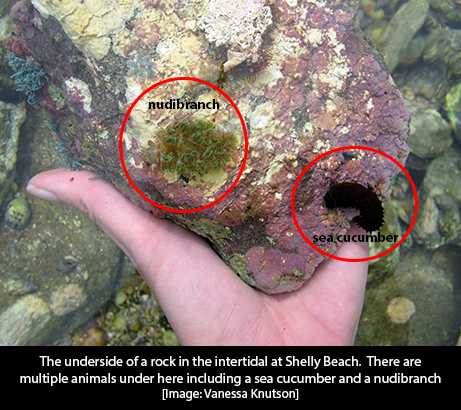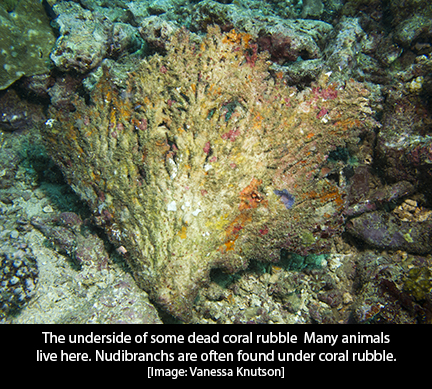Last time I gave you a taste of what it is like to participate in a major expedition. This time I’m going to explain how we actually find and collect nudibranchs and other sea slugs.
First of all, sea slugs can be found just about anywhere in the world’s oceans from the shallow intertidal down to the deep sea, and from the cold polar regions to the warm tropics. Depending on what type of habitat we are trying to sample, we may use different techniques.
No matter what technique we use, one thing that is particularly important to our lab is to make sure that we leave a minimal impact on the habitats that we sample. This means that if we turn over a rock or a dead coral boulder, we make sure to turn it back to the way that it was. We do this because there are many kinds of animals that live on the bottom of or underneath rocks and rubble (like certain kinds of sponges). If you turn over a rock and don’t put it back the way it was, those animals lose their habitat and may not survive. Because of this, we do our best to leave habitats in the same condition as we found them.

Intertidal
For species that are found in the intertidal, we go out during a low tide and wade around and look for slugs. The lower the tide, the better. When I was at Kings Beach in Queensland, Australia, I surveyed the intertidal by wading and turning rocks. I found this technique very effective for this habitat and most of the slugs that I found at this site were hiding under rocks.

Subtidal
While we occasionally sample in the intertidal, most of our sampling happens subtidally (below the low tide mark). The main technique we use to survey for nudibranchs subtidally is SCUBA diving. In Madang, Papua New Guinea we would do about 2 to 3 dives nearly every day. While diving, we turn over rocks or dead coral boulders. It’s really amazing what you can find living under these! Most of the slugs that live on a coral reef are found hiding under coral rubble. For this reason, I get really excited when I find a dive site with a lot of coral rubble! I will also mention that some slugs are only found at night, so to find these, we SCUBA dive at night. Many of the slugs I study are found at night over a sandy bottom. To find these, you want to survey as much of the bottom as possible during the night dive.

Another technique we may use as an alternative to SCUBA is snorkeling or free-diving. At one of my sites in Australia, I looked for nudibranchs while snorkeling. This is a little bit more difficult than SCUBA for me because I’m not able to hold my breath for that long. This made it challenging to turn larger rocks and requires a lot more energy to be constantly free-diving down to the bottom. However, in some ways snorkeling is more convenient and less expensive than SCUBA diving.
Collection
Once we find a slug, we need to get it into a container. This can be a bit tricky because the slugs are very soft, often slippery and usually squishy. It becomes even more challenging if you are working with a very small slug (the size of a grain of rice, or a sesame seed!) and if you have currents in the water. There is nothing worse than a tiny slug floating off in the currents! Typically, I will pick up the slug with my fingers and do my best to place it in a plastic jar underwater. Other people often use plastic bags, but I find the hard containers easier to manage. After the slug is in the jar, I place it in my mesh collecting bag, and go off to find the next slug!

Finding slugs can be quite challenging, but extremely satisfying! Check back in a few weeks to hear about the preservation process!
Vanessa Knutson
Project Lab Coordinator and Graduate Student
Department of Invertebrate Zoology and Geology